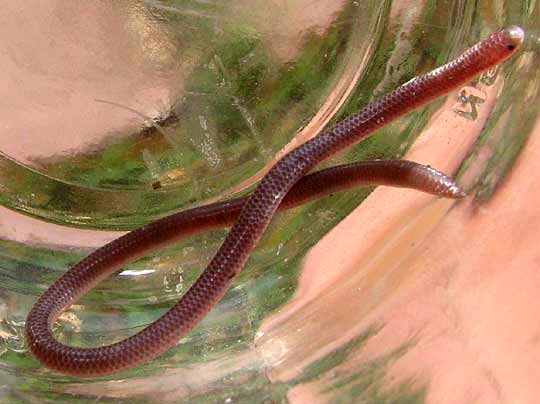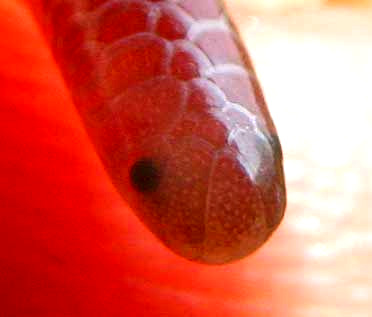Excerpts from Jim Conrad's
Naturalist Newsletter
from the April 21, 2013 Newsletter issued from the Frio Canyon Nature Education Center in northern Uvalde County, southwestern Texas, on the southern border of the Edwards Plateau; elevation ~1750m (~5750 ft); N29.62°, W99.86°; USA
TEXAS BLIND SNAKE
On Monday afternoon neighbor Sharla dropped by with a car full of kids and a glass baby-food jar in which she'd deposited what's shown below.

She'd found the four-inch long (10cm) snake in her house and didn't seem sure whether to be horrified or have a good laugh. On principle she didn't like snakes in her house, but this one was so tiny that even if it had wanted to bite, it couldn't have gotten hold of a finger. I was impressed that she'd noticed the tiny critter's scales and realized that it was a snake and not a worm.
In Mexico we've seen snakes this small and smaller, such as the Goudot's Thread Snake, Leptotypholops goudotii, at http://www.backyardnature.net/mexnat/goudot.htm.
My Audubon field guide for reptiles informed me that Sharla's jar snake was the Texas Blind Snake, LEPTOTYPHOLOPS DULCIS (UPDATE: later changed to RENA DULCIS), thus belonging to the same genus as the thread snake we'd seen in Mexico.
Actually, identifying the snake to species level involved a bit more than just matching pictures in the field guide, for in our area we also might find the very similar Western Blind Snake, Leptotyphlops humilis. However, on the Internet a page describes how to separate them:
"If the scale pattern ... does not include separate supraocular scales between the lateral scale over the eye and the spinal scale, the snake is a Western Blind Snake (L. humilis); but if the supraocular scales are present, it is a Texas Blind Snake (L. dulcis)."
On that page you can see a diagram showing the scales involved, at the BugsintheNews.Info website.
The closest close-up of the head scales I could get is the one shown below:

Consulting the scale diagram, we can see that the supraocular scales are well separated, so that means Texas Blind Snake. In that close-up you can also see that the snake's eyes are vestigial and covered by opaque head scales.
The field guide states that Texas Blind Snakes are nocturnal and seldom seen except on evenings following heavy summer rains. They most frequently occur in damp soil under slabs of rock, logs or other such things, where it feeds almost exclusively on termites, ants and ant pupae.
Texas Blind Snakes occur from southern Kansas to southeastern Arizona, south into arid northern Mexico.